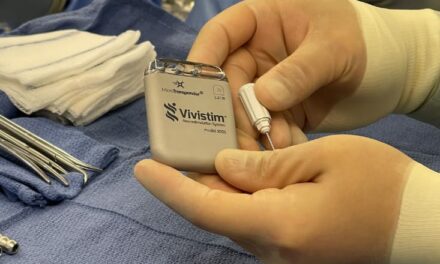Balance is a complex process that involves multiple systems in the body. These include sensory, central nervous, and musculoskeletal systems. The process of restoring balance and mobility post-surgery or for geriatric people, those with arthritis, or those who have had a stroke often entails a myriad of activities and exercises that are performed over time. Physical therapists tailor a rehabilitation regimen for each patient based on the individual’s presentation and the PT’s findings from a patient exam.
At the Long Beach Memorial Medical Center’s Balance and Vestibular Clinic in California, therapists generally provide therapy for patients two to three times a week for 3 to 6 weeks, and prescribe daily at-home exercises, says Jill Trato, PT, NCS. To help reduce hemiplegia and hemisensory impairments for people who have had a stroke, the clinic recommends strengthening exercises in a variety of positions, depending on the patient’s status. These may include the use of affected limbs in gait activities with and without an assistive device, body weight-supported treadmill training (BWSTT), stair climbing, functional retraining, and assorted balance activities. Functional activity training is performed with the consideration of sensory system involvement, she says. “If, for example, someone’s sensation is impaired and the prognosis for recovery is good, they are prescribed [the above-mentioned] strengthening/functional activities with the addition of closing their eyes to improve the use of somatosensory feedback in the maintenance of postural control,” she says. The frequency of training in the clinic as an outpatient is two to three times weekly. “However, we know that repetition and intense practice are crucial for recovery. So, the patient is encouraged to practice at home independently or with assistance.”
POSTOPERATIVE MOBILITY RESTORATION
 |
| Patient Robert Melville undergoes body weight-supported treadmill training with manual facilitation provided for proper gait kinematics by Jill Trato, PT, NCS (left), and Shannon Walters, rehabilitation technician (right), at Long Beach Memorial Medical Center, Long Beach, Calif. |
Cynthia Bauer, PT, DPT, OCS, director of musculoskeletal outpatient services, Good Shepherd, Allentown, Pa, works in an outpatient center associated with a postacute rehabilitation network. The therapists mostly treat postoperative orthopedic cases and musculoskeletal injuries, and arthritic and geriatric patients who need help with ambulation due to deterioration in functioning. Therapists restore mobility after injuries such as multiple fractures sustained in motor vehicle collisions, post-total joint replacements, and post-lower extremity surgeries such as meniscus repair, ACL reconstruction, ankle injuries/sprains, and surgical reconstruction—and train people in walking with assistive devices when there is a decline in their balance or function. Bauer says weight-bearing and mobility restoration can be limited by postsurgical precautions or the injury. Once weight bearing is allowed, the therapists select an appropriate assistive device, depending on patients’ overall health and strength, cognition, living environment, and length of time they may need the aid. “If the patient is to be non-weight bearing on one lower extremity and has a strong upper body, good balance, and good cognition, we would probably prescribe axillary crutches,” Bauer says. “However, if the non-weight bearing patient has reduced endurance and a weaker body, or upper-extremity limitations, we might prescribe a walker.” Therapists adjust the walker or crutches to the proper height, and the patient is instructed on use.
When patients are allowed to become partial weight bearing, the therapists progress them to a single-point or a quad cane—adjusted to the proper height by the therapist—and its use. Patients may progress to a single-point cane or be ready to ambulate without an assistive device as their weight bearing improves and their balance is adequate.
Most people who walk with an assistive device encounter stairs at home or in the community. “We review the proper technique for advancing the limb with the device both with and without a handrail if appropriate,” Bauer says. “When using a cane to ascend stairs, the patient is instructed to advance the stronger limb and then use the cane to assist in stabilizing the body while advancing the affected limb.” The motion is reversed when descending stairs, advancing the cane and affected limb to the lower step and once there, bringing along the stronger limb.
When permitted and possible, patients are advanced to walking without an assistive device, Bauer says. “Usually, normal gait has been reviewed and practiced with the cane so that the natural sequencing and trunk swing have not been replaced with abnormal habits,” she says. “If abnormal gait is adopted during the recovery phases, gait training, including verbal cueing, manual techniques to encourage weight shifting, and exercises, is used to restore the normal movement.” A limp may result if joints have limited mobility, which can be addressed with passive stretching and manual techniques by the therapist. Pain is handled with treatments that aid in healing. Bauer says abnormal weight shifting can be caused by apprehension to begin weight bearing on the previously injured side. “We may address this by using aquatic therapy in our warm water pool,” she says. “The environment allows for less weight throughout the legs when walking.” Patients usually have less pain and become more comfortable with shifting onto the previously injured side, and as their confidence grows, therapists move them from a more supportive area—such as deeper water with parallel bars—to a less supportive area, such as a shallow area with one or no parallel bars, and, eventually, onto the land. Therapists at Good Shepherd add balance exercises beginning on the most stable floor surfaces and progressing to standing on foam or unstable surfaces, such as a wobble board or balance machine.
Patients occasionally have a weight restriction when recovering, Bauer says, which can vary starting with non-weight bearing, then touch-down weight bearing, to partial weight bearing, and then full weight bearing. “Partial weight bearing can be determined in pounds or a percentage of body weight, Bauer says. “This may be determined by the medical diagnosis of the patient and also the surgeon or physician. We may use a scale under the affected foot to allow the patient to feel the weight limit.”
POST-STROKE AND POST-BRAIN INJURY TREATMENTS
People who have had a stroke are helped to reduce their sensory impairments at Long Beach Memorial. For example, having the person lie on the affected side and the provision of tactile input to that side may be beneficial. In addition, eyes-closed activities are used to improve the use of sensory information that is received from the periphery and sent to the brain. “Alternately, compensatory training could be done, such as increasing a person’s use of vision, or the use of assistive devices,” Trato says.
Gait and balance activities suitable for restoring geriatric patients’ mobility depend on what is causing the balance deficit, but Trato says that usually a combination of strengthening, flexibility, and endurance activities is appropriate. “More intense training is usually done in the clinic to ensure safety,” she says. The training may include working on dynamic balance in a variety of task conditions and positions. The frequency of exercise in an outpatient clinic is typically two times a week, with the addition of a home exercise program.
For patients post-brain injury, the clinic uses complex visual environments to decrease reliance on visual feedback in the maintenance of postural control, and to decrease dizziness and motion sensitivity.
For patients with Parkinson’s, treadmill training is often used, with the addition of balance retraining and postural reeducation. “Strength training is performed with muscle groups that have a tendency to become weak in this patient population, and stretching is used for muscle groups that have a tendency to become short and stiff,” Trato says.
A home exercise program is a big component in treating outpatients, and providing the proper motivation is critical in gaining compliance. “The people who are compliant make greater gains and do so faster than those who are not compliant,” Trato says. “It is an art to discover how to motivate people to participate and this differs on a case-by-case basis.” Parameters for the home exercise prescription are established within the clinic by observing the client’s form and response while performing the exercise, which guides the number of reps or the amount of time an exercise is prescribed. Long Beach PTs work with occupational therapists, who may visit a patient’s home to suggest modifications, if needed.
At Southwest Advanced Neurological (SWAN) Rehab in Phoenix, locomotor ability is often one of the key goals for stroke survivors. SWAN’s therapists use practice paradigms for locomotor training that are known to improve gait function and produce activity-dependent plasticity of the brain, says owner Kay Wing, DPT, NCS, GCS, noting that many studies show that treadmill training, with and without body weight support, has been more effective than conventional therapy alone for improvement of balance, motor recovery, gait velocity, and endurance. The facility uses products for weight-bearing assisted treadmill training (WBATT) that provide a safe and effective environment for walking. “WBATT has altered gait training techniques, as well as expectations of outcome,” Wing says. The system allows therapists to train, and patients to practice, proper gait patterns, with the numerous repetitions needed to retrain the muscles and brain.
Gait speed is an important factor in ambulation training. “There is a minimum speed that must be attained in order to safely and comfortably participate in community activities,” Wing says. “Training gait speed, which more approximates community ambulation speeds (.8 m/sec or 2.0 mph), has been shown to be more effective than slower speed training.” The increased speed also allows many more repetitions of stepping. BWSTT is one of the most effective methods to train gait speed. Patients may walk one-half to three-quarters of a mile during a 45-minute session on the treadmill, Wing says. The therapist is often needed to assist the patient’s lower extremities, to enhance the quality of movement and improve speed, she says.
In addition to gait-training activities, SWAN’s patients often participate in a daylong or half-day whole-body therapy program that incorporates balance and gait activities, upper-extremity task repetitions, and strength training.
Judy O’Rourke is the associate editor for Rehab Management. For more information, contact .




